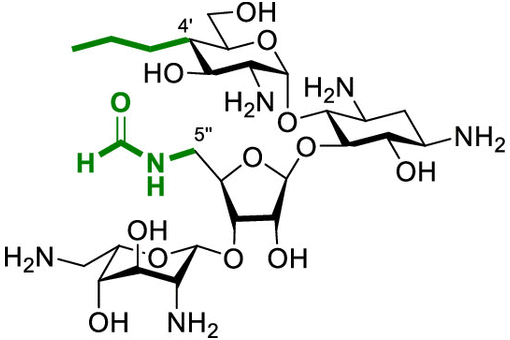Lubriks, D.; Zogota, R.; Sarpe, V., A.; Matsushita, T.; Sati, G., C.; Haldimann, K.; Gysin, M.; Böttger, E., C.; Vasella, A.; Suna, E.; Hobbie, S., N.; Crich, D. ACS Infect. Dis. 2021, 7, 2413–2424.
DOI: 10.1021/acsinfecdis.1c00158
Abstract
Propylamycin (4′-deoxy-4′-propylparomomycin) is a next generation aminoglycoside antibiotic that displays increased antibacterial potency over the parent, coupled with reduced susceptibility to resistance determinants and reduced ototoxicity in the guinea pig model. Propylamycin nevertheless is inactivated by APH(3′)-Ia, a specific aminoglycoside phosphotransferase isozyme that acts on the primary hydroxy group of the ribofuranosyl moiety (at the 5′′-position). To overcome this problem, we have prepared and studied the antibacterial and antiribosomal activity of various propylamycin derivatives carrying amino or substituted amino groups at the 5′′-position in place of the vulnerable hydroxy group. We find that the introduction of an additional basic amino group at this position, while overcoming the action of the aminoglycoside phosphoryltransferase isozymes acting at the 5′′-position as anticipated, results in a significant drop in selectivity for the bacterial over the eukaryotic ribosomes that is predictive of increased ototoxicity. In contrast, 5′′-deoxy-5′′-formamidopropylamycin retains the excellent across-the-board levels of antibacterial activity of propylamycin itself, while circumventing the action of the offending aminoglycoside phosphotransferase isozymes and affording even greater selectivity for the bacterial over the eukaryotic ribosomes. Other modifications to address the susceptibility of propylamycin to the APH(3′)-Ia isozyme including deoxygenation at the 3′-position and incorporation of a 6′,5′′-bis(hydroxyethylamino) modification offer no particular advantage.

